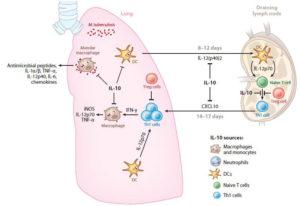The need for new Tuberculosis (TB) diagnostic tools was highlighted as one of the major improvements required to combat the TB epidemic. One of the major challenges of this epidemic is the lack of non-microbial TB diagnostic tools to distinguish between asymptomatic M.tb infection (LTBI) and TB, pulmonary TB (PTB) the major form of the disease, as well as the difficulty to diagnose extra-pulmonary TB (EPTB).
Srabanti Rakshit, PhD candidate from the Indian Institute of Science, presented her work which aimed to determine unique T cell features that can distinguish LTBI, PTB and EPTB (Rakshit et al.). M.tb-specific CD4 T cell functional profiles were characterized in response to antigen stimulation with either M.tb DosR regulon encoded latency antigens, which have been shown to be preferentially recognised by individuals with LTBI but not PTB, and immunodominant secretory antigens, ESAT-6, CFP10, TB10.4 and Ag85.
Rakshit showed that CD4 T cell responses from individuals with PTB expressed lower frequencies of Th1 and Th17 cytokine producing cells in response to stimulation with latency antigens compared to individuals with LTBI and EPTB. Despite similar frequencies of cytokine producing cells between LTBI and EPTB, the overall memory phenotype of M.tb-specific T cells were drastically different. Where M.tb-specific CD4+ T cells from individuals with LTBI were predominantly central memory, where as individuals with PTB and EPTB possessed significantly higher proportions of effectors cells, characteristic of their high antigen burden. Additionally, Rv1737 but not other latency antigens could easily distinguish M.tb-specific responses LTBI, EPTB and PTB, where individuals with LTBI had significantly higher proportions of polyfunctional CD4 (and CD8) T cell responses than both EPTB and PTB individuals. Finally, Rakshit also showed that individuals with LTBI possesed higher proportions of IL-10+Th17 (regulatory) responses than EPTB and PTB individuals.
In summary, this data presented by Srabanti Rakshit illustrated the potential use of DosR regulon antigen, Rv1737 in a diagnostic antigen stimulation assay to distinguish LTBI, EPTB and PTB.
Journal Article: Rakshit et al., 2017. Circulating Mycobacterium tuberculosis DosR latency antigen-specific, polyfunctional, regulatory IL10+ Th17 CD4 T-cells differentiate latent from active tuberculosis. Scientific Reports
Article by Cheleka AM Mpande












